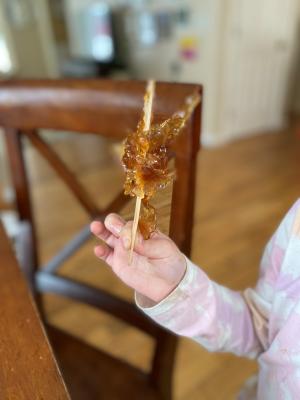... and the owners who work hard to protect them and come together to tap them.
Evan Berry spent an afternoon sledding at the home of Jim and Marilyn Mahoney while their sugarhouse sat idle because of the cold temperatures. (Photo: Anna Berry)
My favorite sign of spring is the start of maple season. From tree to table, I teach my children that it's a sweet reminder our forests are always working.

This year’s weather, however, led my usual lesson in a new direction — from table to tree. Two weeks ago, we took advantage of a snow day to make maple taffy from syrup given to us by lifelong friends and Forest Society members, Jim and Marilyn Mahoney, who have a sugarhouse in Goffstown. Although neither of my children enjoys maple syrup on pancakes, they both loved the taste of the sticky maple syrup twisted onto popsicle sticks and rolled into curlicues from the snow.
But, by the time we visited the Mahoneys in early March to watch the sugaring process, we had already missed the first boil of sap — 15 gallons worth — and it wasn’t yet warm enough for more sap to run.
Instead, we followed the tubing lines around their yard like a maze and took advantage of the hill behind the sugar house for sledding. We also talked about the heart of the sugaring process: trees. Whether you are a backyard hobbyist or a major maple producer, you need access to a lot of tree sap. 40 gallons of sap produce approximately one gallon of maple syrup and each tap on a tree can yield 10 gallons of sap over the season, according to UNH Extension.
For the Mahoneys, who began making syrup after they moved to Goffstown in 1986, a conservation easement on their 4-acre property has helped them protect their passion and is part of a larger conservation corridor in their neighborhood. It’s also created a sense of community.
Marilyn, standing outside in a shirt printed with the motto, “Life is too short for fake maple syrup,” said they started with a line of ancient, old maples on a nearby property. They didn’t want to tromp through miles of forest to empty sap buckets.
“We didn’t have tubing — that was essential,” she said. “Then, the other neighbors said, ‘We have maple trees!’”
Now, 90 percent of the trees they tap belong to neighbors, who receive bottles of syrup in return for the sap. And, close to 40 acres in the surrounding area are protected by a conservation easement, thanks to the Piscataquog Land Conservancy. It makes good sense to think long term when sugar maples can be tapped for hundreds of years.
The Piscataquog Land Conservancy is one of many land trusts in New Hampshire, including the Forest Society, that hold conservation easements. A conservation easement deed is a permanent, legally binding agreement between a landowner and a qualified conservation organization or public agency that restricts use of the land to protect its significant natural features.
Typically, conservation easements held by the Forest Society allow the landowner to continue to use the land for agriculture, forestry, noncommercial outdoor recreation, wildlife habitat management and all other uses that are compatible with the conservation goals for the property and not specifically prohibited by the easement terms.
At the other end of the spectrum, larger maple producers have the option of leasing trees. Leasing maple trees on the Forest Society’s protected land involves first formalizing a written lease that will be in place for a specified period of time, anywhere from 5 to 10 years. Field Forester Steve Junkin noted that the agreement spells out the most current and accepted tapping practices which preserve tree health and productivity for the long term.
The Forest Society has a handful of maple leases on its 190,000 acres of protected land across the state, ranging in size from 100 taps to 6,000 taps. At The Rocks in Bethlehem — a 1,400-acre Forest Society property that is home to a working Christmas Tree Farm — there are around 1,000 taps managed by sugarmaker Brad Presby, of Presby’s Maple Farm. Maple syrup from The Rocks’ sugarbush is then sampled and sold during maple tours in March and April at the farm and at the Forest Society’s Conservation Center in Concord.
I’m thankful that the state’s maple celebration, once just a weekend, has turned into a month-long festival organized by the NH Maple Producers Association. As a city dweller who counts my property in square feet and has zero sugar maples, I’m looking forward to getting back to the sugarhouse for my first taste of spring.
Maple Month activities:
- Find a sugar house that is open for in-person sales or tours here: nhmapleproducers.com
- Visit the Forest Society’s tree farm in Bethlehem, The Rocks, for tours on March 19, 20, 26, 27 and April 2. Tours include a horse-drawn carriage ride and a visit to the NH Maple Museum. Tickets: nhmapleexperience.com
- Learn more about our region’s original sugar makers, the Abenaki people, from the Indigenous New Hampshire Collaborative Collective’s website: indigenousnh.com
- Watch a video of the Berry family making maple taffy on the Forest Society's Instagram reels.
Anna Berry is the digital outreach manager for the Forest Society and can be contacted at aberry@forestsociety.org.
